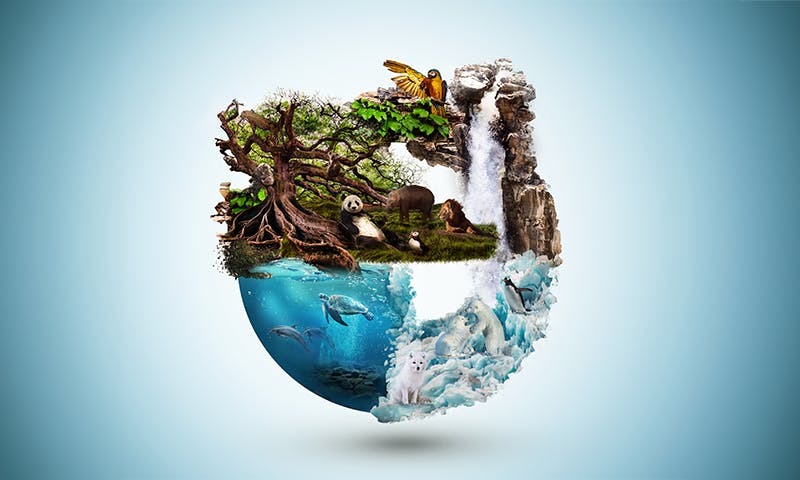1 Life is Everywhere
Only a few decades ago, the idea that life might exist more than one mile below the planet’s surface, or high above us in the clouds, was considered laughable by most scientists. Today, it’s widely accepted that life inhabits both extremes and everywhere in between. In just about every part of the planet we’ve been able to access—the frigid poles and scorching deserts, the tallest mountain peaks and the deepest parts of the ocean—we have found life.
Scientists exploring ultra-deep gold mines have discovered a variety of microbes living within tiny fluid-filled crevices nearly two miles underground in the planet’s deep crust. Many of these microbes are quite different from their counterparts on the surface, breathing rock instead of oxygen, growing very slowly, only occasionally reproducing, and extruding metal byproducts.

Similarly, researchers have discovered that winds and storms routinely whisk a wide array of microscopic organisms and tiny biological particles from the continents and oceans into the atmosphere. These aeroplankton, as they’re sometimes known, become seeds for rain clouds and for ice crystals within those clouds, thereby forming an important part of the water cycle. Some seem to be capable of remaining aloft for weeks at a time, perhaps even eating and reproducing within clouds, before eventually returning to the surface in the very precipitation they help stimulate.
2 Life is an Extension of Earth
We typically speak of life inhabiting the planet or residing on its surface. As complex, dynamic, and social animals, we tend to see ourselves and other similarly active creatures as the main actors in the saga of life—and our environment as the mere backdrop to our theatrics, the stage on which we perform. Countless books and articles have been written about “the evolution of life on Earth.” Yet life and environment cannot be separated in this way. Life emerged from Earth, is made of Earth, and returns to Earth. What we call life is not simply something that resides on the planet—it is a literal, physical extension of the planet.
What we call life is a literal, physical extension of the planet.
To better understand this concept, I like to make an analogy to a vast beach from which spontaneously emerge elaborate sandcastles and other intricate self-assembled sculptures. Just because these structures have attained new levels of complexity and organization does not mean they are suddenly divorced from the beach. They are still made of the same particles of sand that surround them. They are still the beach. So it is with life and Earth. We and all living creatures are not mere inhabitants of Earth—we are Earth. Life is Earth animated.
3 Earth Itself is Alive
Once we accept that life is everywhere, and that life is an extension of Earth, we have taken the first big conceptual leap toward recognizing that Earth itself is alive.
In addition to being continuous with Earth, life gives our planet an anatomy and physiology. As science has revealed, our planet is suffused with life: with microbes, plankton, pollen, and spores; moss, algae, lichen, and leaves; roots and mycelial networks; reefs, forests, grasslands, and peat. The ubiquitous presence of life dramatically increases the planet’s surface area that is capable of storing and transforming energy, exchanging gases, and performing complex chemical reactions—in other words, that is capable of the very biochemical processes we associate with life. Consider how much more surface area the land has with its cloak of leaves and branches, that the ocean has with its innumerable life forms, and that even the atmosphere has with its airborne microbes. Collectively, these organisms comprise Earth’s living tissues—a colossal animate body with a planetary-scale physiology and metabolism.
Moreover, organisms and their environments continually coevolve, each profoundly changing the other throughout geologic time. Many of the planet’s defining features—its blue sky, breathable atmosphere, high mineral diversity, fertile soils, frequent wildfires, and ocean chemistry—are at least partly products of life. The ways in which life alters the planet’s geology and chemistry loop back to influence the evolution of species.
As such, Earth and life form a single evolving system. That system has demonstrated a capacity for self-regulation—repeatedly pulling itself back from climatic extremes such as deep freezes—and an astonishing resilience—having endured for more than 4 billion years. Earth, then, is not simply a planet with life on it, but rather a living planet—the largest known living system. Earth itself is as alive as we are. ![]()
Lead image: Dilyana Design/ Shutterstock
-
Ferris Jabr
Posted on June 18, 2024
Ferris Jabr is a contributing writer for The New York Times Magazine and the author of Becoming Earth: How Our Planet Came to Life. He has also written for The New Yorker, The Atlantic, Harper’s, Outside, WIRED, and National Geographic. His work has thrice been anthologized in The Best American Science and Nature Writing series.
Get the Nautilus newsletter
Cutting-edge science, unraveled by the very brightest living thinkers.




